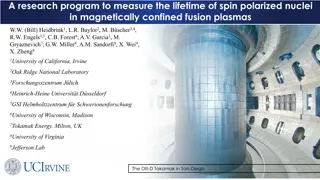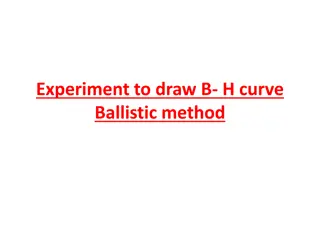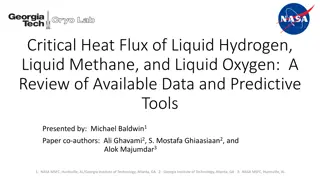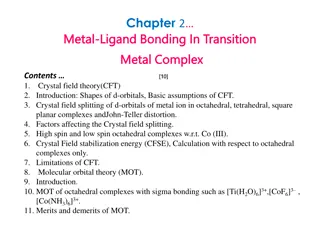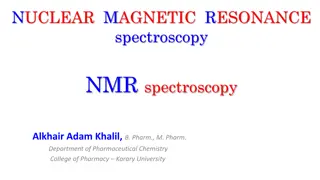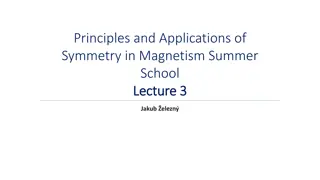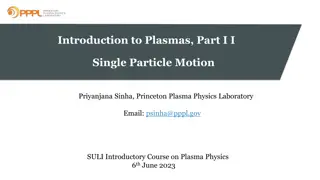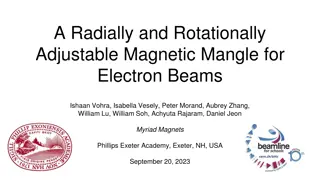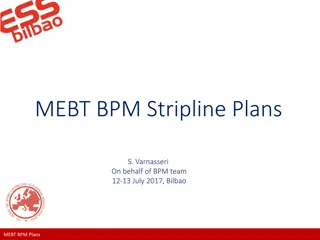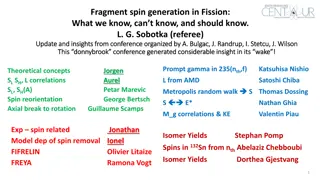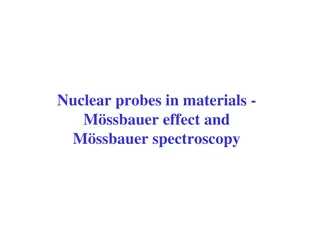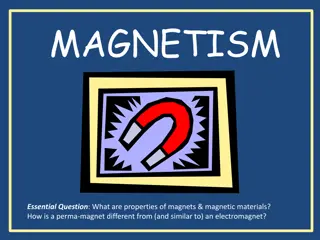Understanding AGN Jet Production Efficiency: Insights from Spin and Magnetic Flux
A fundamental question in astrophysics is how efficiently active galactic nuclei (AGN) produce jets. Black hole spin and magnetic flux play crucial roles in determining the jet production efficiency. High-spin values and large magnetic flux threading are essential for generating high-efficiency jets in AGN. The balance between BH spin and magnetic flux is controlled by the Blandford-Znajek mechanism. Simulations suggest that GRMHD models with significant initial magnetic flux can lead to jet efficiencies exceeding 100%. Gravity sets limits on the magnetic field strength accumulation, leading to the formation of magnetically arrested disks (MADs) in some AGN sources. Testing the MAD scenario in radio-loud AGN helps understand the saturation value of the jet magnetic field strength.
Download Presentation

Please find below an Image/Link to download the presentation.
The content on the website is provided AS IS for your information and personal use only. It may not be sold, licensed, or shared on other websites without obtaining consent from the author. Download presentation by click this link. If you encounter any issues during the download, it is possible that the publisher has removed the file from their server.
E N D
Presentation Transcript
Is everybody MAD? Is everybody MAD? Tuomas Savolainen Aalto University Mets hovi Radio Observatory, Finland
A fundamental question: A fundamental question: AGN efficiently produce jets? efficiently produce jets? why only some why only some AGN Sikora et al. 2007 Black hole mass and accretion rate alone cannot determine the jet production efficiency ??= Blandford-Znajek mechanism gives two other parameters: BH spin and magnetic flux threading it, since ?? ?? ?? ??2. 2 ? 2. 22.9.2023 2
Spin vs. magnetic flux Spin vs. magnetic flux as a controlling parameter as a controlling parameter Spin paradigm The range in jet production efficiency is (only) due to a range in BH spin values In a case of thick accretion disks, power variations of ~1000x are possible for realistic spin distributions (Tchekhovskoy et al. 2010) However, modelling X-ray reflection spectra of radio quiet AGN finds large spin values Magnetic flux paradigm Production of high efficiency jets requires both high spin and large magnetic flux threading the hole, and it is the magnetic flux that dominantly controls the jet production (Sikora & Begelman 2013) AGN jet production depends on the accretion history, i.e., whether the system had enough time and correct conditions to accrete high enough magnetic flux (extended period of hot mode accretion) 22.9.2023 3
High High jet jet efficiencies efficiencies in in simulations simulations Tchekhovskoy et al. (2011) GRMHD simulations with a large initial magnetic flux produce >100% jet efficiency for spins of a>0.9 and lead to saturation of the magnetic flux threading the BH at ??~50 1/2 ???2? 22.9.2023 4
Gravity sets maximum Gravity sets maximum ??? Gravity limits BH B-field strength accumulation only until magnetic pressure balances ram pressure of the accreting gas (magnetic version of the Eddington limit): 0.5 ???2 Disk 0.5[G] ???? 0.1???? ??? 109? BH ????~104 ?? ?? When ? ????: Jet power is maximized B-field becomes dynamically important and a magnetically arrested disk (MAD) is formed Are sources with high ?? MADs? R Image courtesy of A. Tchekhovskoy 22.9.2023 5
Testing MAD scenario in radio Testing MAD scenario in radio- -loud loud AGN AGN 1/2 ?acc 1/2?BH and the saturation value of the ???2? In the MAD state: ??= ??? magnetic flux is ??? 50 Measuring the jet magnetic field strength from e.g., core shift allows one to estimate jet poloidal magnetic flux, jet. Assuming flux freezing allows one to equate jet with BH. From Zamaninasab et al. (2014): Assume that jet B-field is dominated by the azimuthal component ?? at the distance of the VLBI core and ?? ?? ???/??. Core-shift gives ?1 jet= ???? ??(1 ?) jet half-opening angle (assume ??= 1/ ), ? is distance along the jet, ? is the ratio of field line angular frequency to horizon angular frequency (assume ?=0.5), and ? is the maximum Lorentz factor of the jet if all of its Poynting flux is converted to kinetic flux (assume = ?/2). ?? ?? = 2? ??????? 2??= , where is the jet Lorentz factor, ?? is the intrinsic 22.9.2023 6
?/???? ???? vs. vs. ???? for 76 blazars and radio galaxies for 76 blazars and radio galaxies 68 blazars from MOJAVE with core-shift measurements from Pushkarev et al. (2012) + 8 nearby AGN ?BH and ?acc estimated from scaling relations using optical broad emission lines (for nearby sources ?BH from reverberation mapping or stellar velocity dispersion when available) Partial correlation analysis removing the common dependence on ???, ? gives >3 correlation ???= 52 5. Matches with the MAD prediction! AGN with powerful jets are often MADs. ? = 1 ? = 0.4 ??= 1 Zamaninasab et al. (2014) 22.9.2023 7
What about sources that What about sources that produce jets less efficiently? produce jets less efficiently? High-?? sources appear to often have MAD-level magnetic fluxes. What about low-?? sources? Can we create an observational test of the magnetic flux paradigm? Yes: measure magnetic flux (from VLBI core-shift or spectral turnover) for sources with significantly lower jet production efficiencies than in Zamaninasab et al. (2014). Even better: try to also measure their BH spin from X-ray reflection spectroscopy. 22.9.2023 8
A A VLBA VLBA + + XMM XMM/ /NuSTAR NuSTAR pilot pilot A sample of low-to-intermediate R sources that still exhibit jets/cores (RQQ/RIQ) and have reasonable flux densities for core-shift measurement were observed with the VLBA using multi-frequency phase-referencing for relative astrometry. The pilot sample has four targets and covers R = 1.5 195. H1821+643 had a spin measurement. Additionally, we obtained XMM+NuSTAR spectra for IIIZw2 and PG2209+184. 22.9.2023 9
A case study: III A case study: III Zw Wara Chamani s PhD thesis Zw 2 2 22.9.2023 10
XMM XMM/ /NuSTAR NuSTAR observations of III observations of III Zw Zw 2 2 Joint XMM/NuSTAR observations in 2017, archival Suzaku (2011) and XMM (2000) data Signs of a reflection spectrum: soft excess, potential Fe K? line, potential Compton hump Can be also fit with a warm absorber + black body, but the required BB temperature is high (~140eV) Residuals of absorbed power-law model Chamani et al. 2020 22.9.2023 11
XMM XMM/ /NuSTAR NuSTAR observations of III observations of III Zw Zw 2 2 Jointly fit the XMM (2000) and XMM/NuSTAR (2017) data with a reflection model RELXILL (Garcia et al. 2014; Dauser et al. 2014) Constrain disk inclination based on the radio jet kinematics Chamani et al. 2020 High spin! (if the model is correct) 22.9.2023 12
Multi Multi- -frequency frequency VLBA VLBA astrometry of III astrometry of III Zw Zw 2 2 Quasi-simultaneous 4/8, 15 and 24 GHz phase-referencing observations of III Zw 2 and three nearby calibrators (sep. 0.82, 0.98 and 1.91 deg) Chamani et al. 2021 22.9.2023 13
Multi Multi- -frequency frequency VLBA VLBA astrometry of III astrometry of III Zw Zw 2 2 Chamani et al. 2021 Quasi-simultaneous 4/8, 15 and 24 GHz phase-referencing observations of III Zw 2 and three nearby calibrators (sep. 0.82, 0.98 and 1.91 deg) Calibrators have extended structure: we measure their core-shifts with self-referencing Combine relative astrometry and calibrator core-shifts to measure III Zw 2 core shift 22.9.2023 14
Upper limit to the core Upper limit to the core- -shift of III shift of III Zw Zw 2 2 Geodetic block calibration of the (slowly varying) residual zenith tropospheric delay. Ionospheric delay calibration by global GNSS-based ionosphere maps. Special care to estimate the error budget (therm., tropo., iono., core-ident.) No core-shift for III Zw 2 detected. 1-? upper limit: 0.16 mas between 4 and 24 GHz! Chamani et al. 2021 22.9.2023 15
Magnetic field strength limits Magnetic field strength limits From the core-shift upper limit: ?1 ?1 equipartition and using core flux density) From the SSA turnover: ?1 not resolve the jet in transverse direction) 60 mG (assuming equipartition) 4 mG (not assuming 20 mG (upper limit since we do Chamani et al. 2021 22.9.2023 16
MAD or not? MAD or not? The highest upper limit for jet (from core-shift magnetic field assuming equipartition) is five times lower than the predicted BH,MAD, other upper limits are lower III Zw 2 seems to be a failed MAD, which can explain its relatively low jet production efficiency, despite the high BH spin Demonstration of a new test for magnetic flux paradigm. Need to analyze more sources with weak(ish) jets Chamani et al. 2021 CS, eq. SSA CS, non-eq. 22.9.2023 17
Epilogue: A few cautionary Epilogue: A few cautionary words about the equations words about the equations The equation for the magnetic field strength from Hirotani (2005) has a mistake in the (1+z) term, which has been propagated to a number of papers since then (including Z14): 0.25 3 1+?2 ?? ???2sin2? Wrong: ?1 0.025 22.9.2023 18
Epilogue: A few cautionary Epilogue: A few cautionary words about the equations words about the equations The equation for the magnetic field strength from Hirotani (2005) has a mistake in the (1+z) term, which has been propagated to a number of papers since then (including Z14): 0.25 3 1+?? ?? ???2sin2? Right: ?1 0.025 22.9.2023 19
Epilogue: A few cautionary Epilogue: A few cautionary words about the equations words about the equations There is an inconsistency in Z14 when it comes to the assumptions of ??: Pushkarev et al. assumed ??= 0.13/ for ?1 , while jet was calculated assuming ??= 1/ . Several people have pointed this out, but often made another mistake by not taking into account the fact that ??= 0.13/ means that more magnetic energy has been converted to kinetic energy than in ??= 1/ case and one cannot assume =? 2 like in Z14! 22.9.2023 20
Epilogue: A few cautionary Epilogue: A few cautionary words about the equations words about the equations Zdziarski et al. (2015) consider the general case where jet magnetization ?? ? with ? 1 Assuming ?=0.5 and ? = 1, jet= 8 1033? ? 1 + ? 2 ? = 1 2 ??? 109? (?1 1?) Assuming ? = 1, ?? 1, and correcting the (1+z) term in ?1 equation then gives Chamani et al. 2021 22.9.2023 21
Conclusions Conclusions We have observational evidence indicating that AGN with powerful, high- efficiency jets are often MADs. This is compatible with the idea that magnetic flux threading the black hole is the dominant parameter controlling whether an AGN launches a powerful jet. We have developed an observational test for this: find sources with low- efficiency jets, for which it is still possible to measure the magnetic flux from the core-shift (or SSA turnover) using multi-frequency VLBI astrometry. If possible, obtain high-SNR X-ray spectra to estimate spins of these sources. A pilot study has been carried out and the results for III Zw 2 demonstrate that the approach is feasible (although laborious and creating a large sample is difficult). The high spin and sub-MAD magnetic flux in this source are compatible with the magnetic flux paradigm . 22.9.2023 22

















